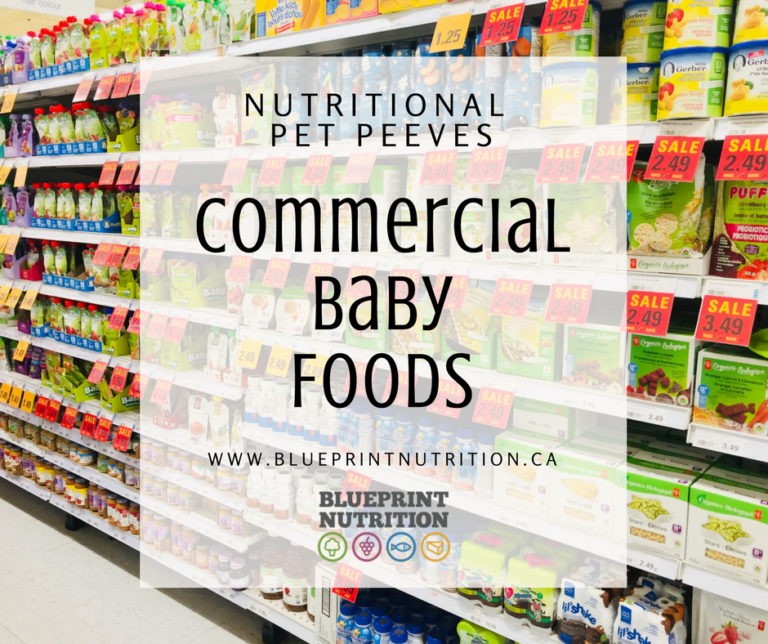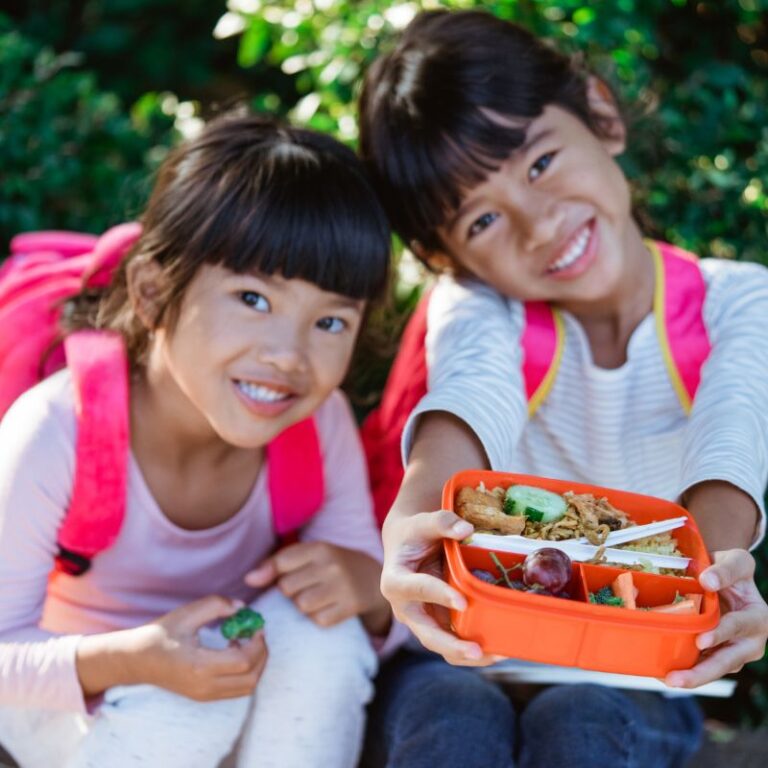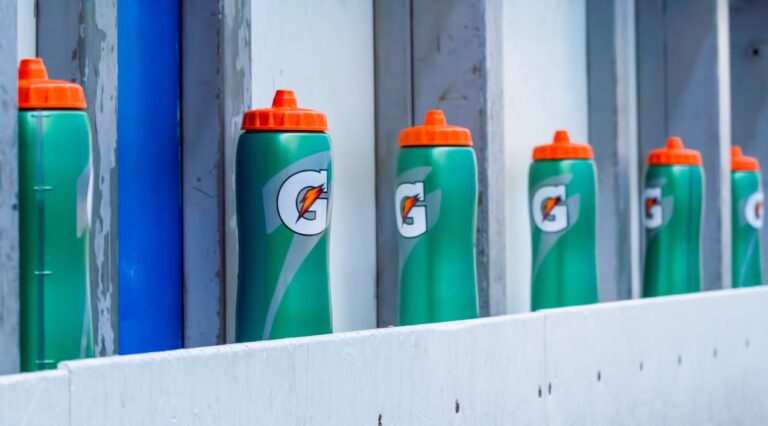While I was at the grocery store the other day, I took a short-cut down the baby food aisle on my way to the check-out. As I was walking, I couldn’t help but to scan the products that lined the shelves from top to bottom. Suddenly, I had an “ah-ha” moment and I knew that the inspiration for my next blog was about to be birthed (pardon the pun!)
The food industry makes it quite clear that ready-to-eat commercially prepared baby foods are nutritional superstars, with packages boasting organic labels and exotic foods combinations including acai berry and kale. But are these baby foods really all that nutritious? Or do companies know exactly how to market their products to make it seem like their foods are healthier and safer then those that you make at home? Let’s take a look.
A couple quick disclaimers before I move on:
1) I am not highlighting these foods because they are evil and will harm your child. My goal is to point out some lesser/unknown facts about them and why you may want to try some alternative options.
2) I have given my children most of these packaged baby foods at one time or another – sometimes out of convenience (i.e. traveling), and sometimes out of curiosity. Whatever you take away from this article, please don’t judge other parents for their choices. Focus on your child and your goals. Enough said.
#1 Baby Foods: Squeeze pouches
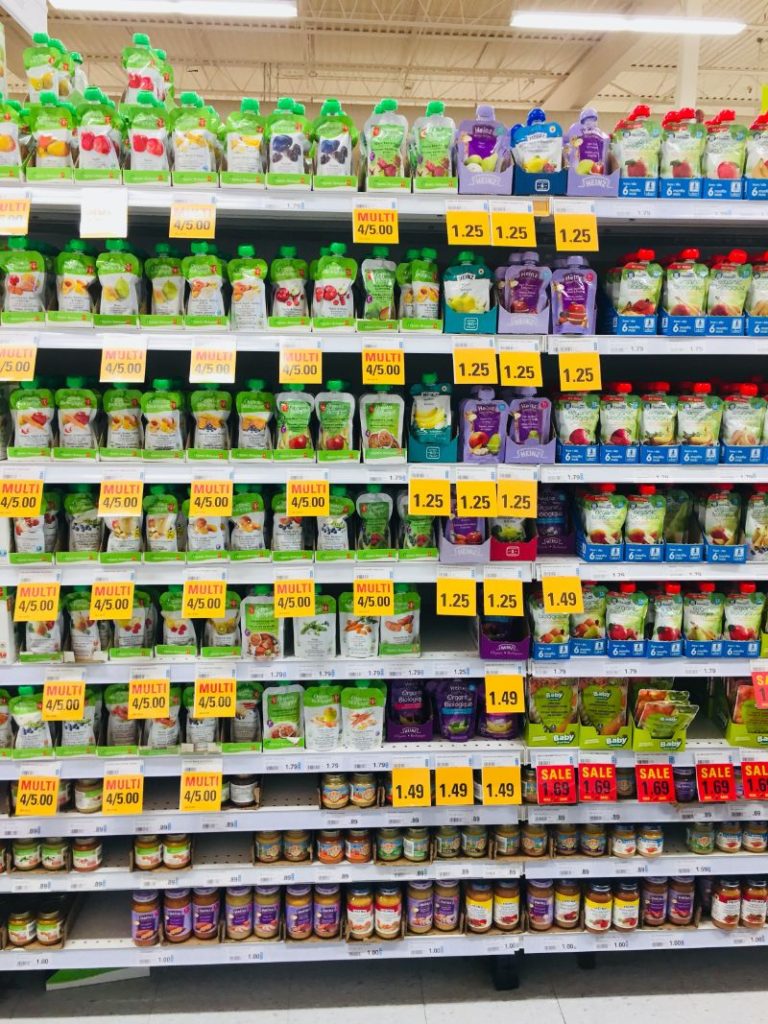
“Squeezies”, as I like to call them, seem to have taken over the baby food aisle. Have you noticed their sprawl? I equate it to the sprawl of Toronto homebuyers invading the Waterloo region (my apologies, I digress…) Almost all the leading baby food companies produce these pouches including President’s Choice Organics, Love Child Organics, Baby Gourmet, Earth’s Best, Heinz, and Gerber to name a few. Essentially, pouches are the new baby food jars of days gone by. Why the switch from jars to pouches? I’m assuming it is because they pack easier, weigh less, and eradicate worries regarding broken glass accidents with your 6-month-old babe nearby. So why do I get a bit peeved with these pouches? Here are three reasons.
The majority contain mostly applesauce.
If you look at the fruit pouches and even some of the veg and meat combos, many of them are applesauce-based (i.e. it’s the first ingredient or one of the first ingredients) and they contain much less of the other exotic fruits that they claim to be inside. For example, Baby Gourmet Wholesome 4 Coconut, Kiwi & Mangosteen with Quinoa squeeze pouches sound amazing, until you read the ingredient list (organic apple, organic banana…) and realize that the first two ingredients, which are present in the largest quantity, are not even listed in the title. Sigh.
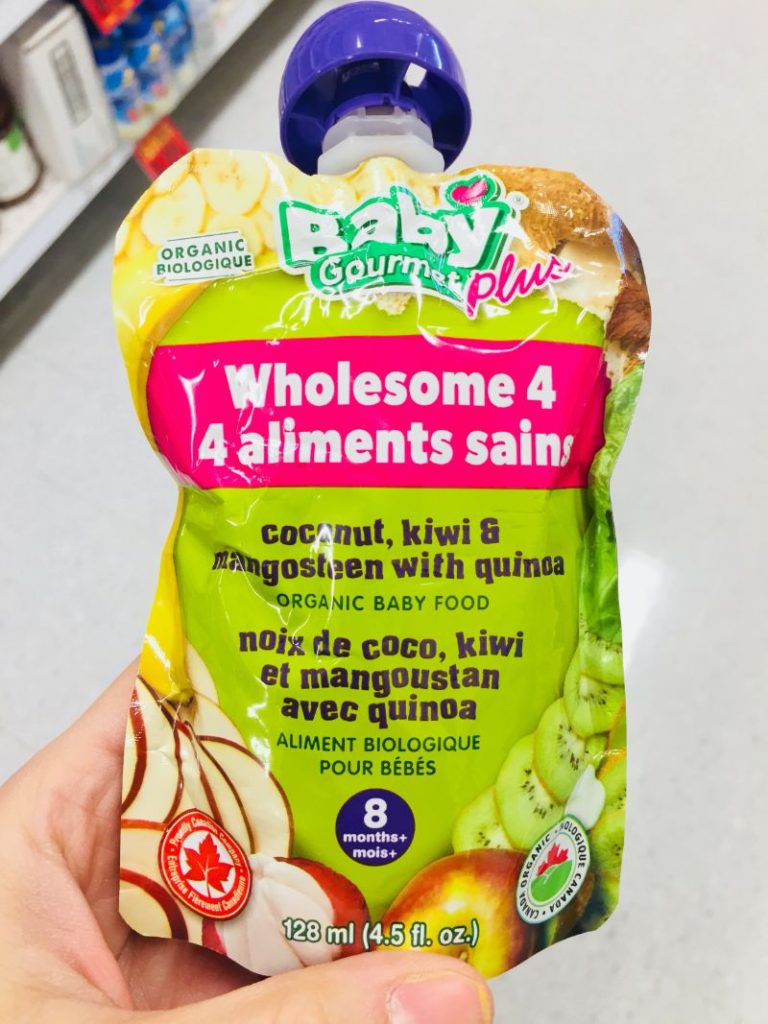
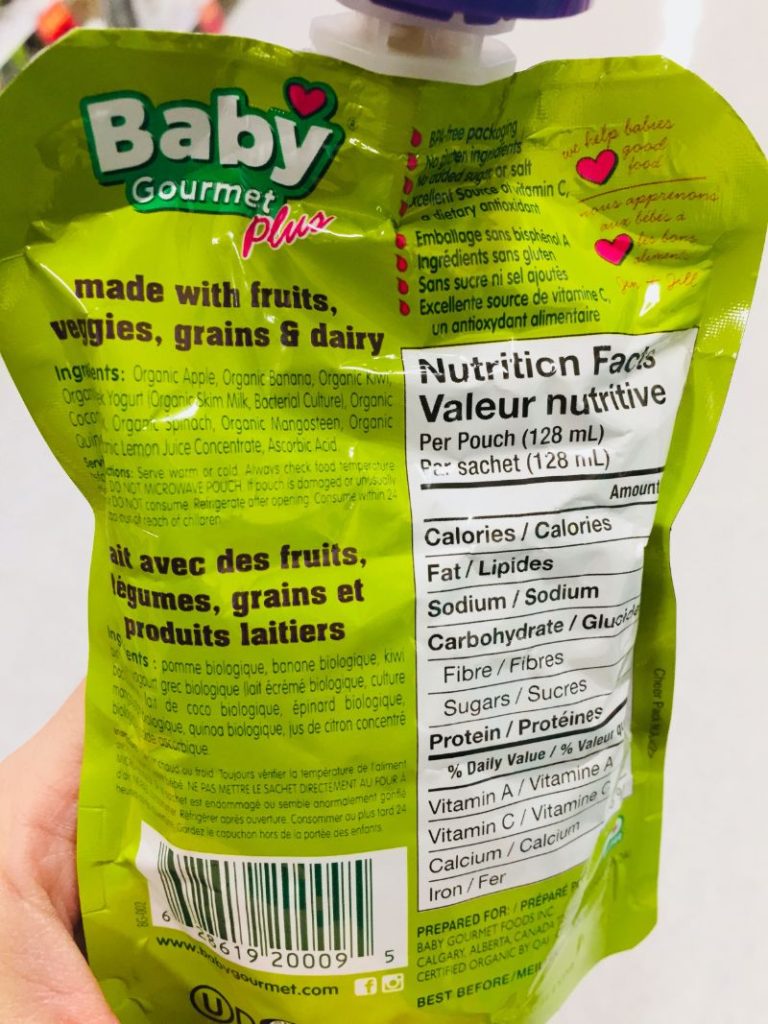
You’re buying expensive applesauce.
You can buy a 128-mL pouch (which we now know is essentially applesauce) for $1.75 OR you can buy a 650-mL jar for $2.00 or less (i.e. $0.40 per 128 mL serving). Hmmm. I know which one I would choose, economically speaking. There are some pouches that don’t contain applesauce, you just have to look a little bit harder for those ones.
Pouches are all one texture – puree.
I have seen children who almost solely exist off these pouches and have not developed the muscles required to chew real food. I believe that purees are developmentally appropriate for babies just starting to eat but that this phase should not last for long. Almost immediately, texture needs to be introduced. When you make your own food, you can leave some texture in there almost immediately and you can increase the texture overtime so your babe learns to chew and handle many different textures.
So what’s my alternative to squeeze pouches: make your own baby food. You don’t need to own a blender, nor do you need to batch prep millions of tiny ice cubes of pureed food. A cheap baby food mill will do. Use the food right off your dinner table (assuming you eat a heathy whole foods diet with lots of iron-rich foods), and you can even offer some of the cheap applesauce you bought if you want! The taste difference between homemade vs. packaged is quite shocking! If you don’t believe me, try it yourself. Seriously! Does taste matter to babies? Yes, it does. You likely want your baby to develop a taste and appreciation for real foods, not packaged ones. Ignite those taste buds and get them revved up from day one on whole real foods with all their sweet, sour, bitter and umami tastes!
#2 Baby Foods: Puffs
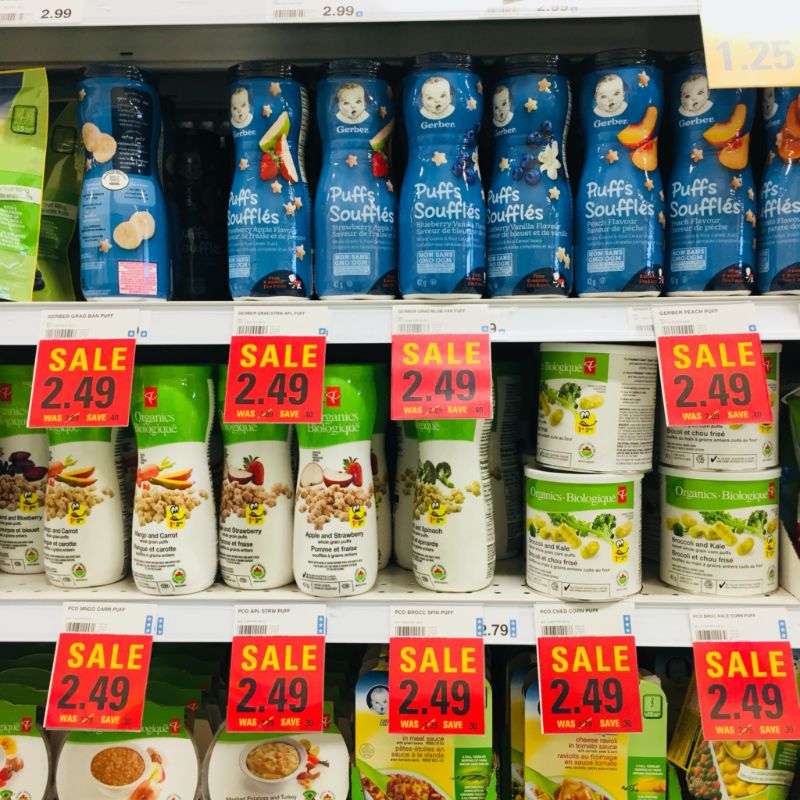
Puffs are another popular pick. What’s not to like about a can of whole-grain broccoli and kale puffs? The name sounds super-duper healthy, and the fact that you can keep these in the diaper bag to help quell a meltdown or tide a hungry babe over until you get home from shopping is convenient.
Let’s pull out our magnifying glass to see what is in one of these cans of puffs. This comes from a can of President’s Choice Purple Carrot and Blueberry Whole Grain Puffs: (the parentheses are my addition)
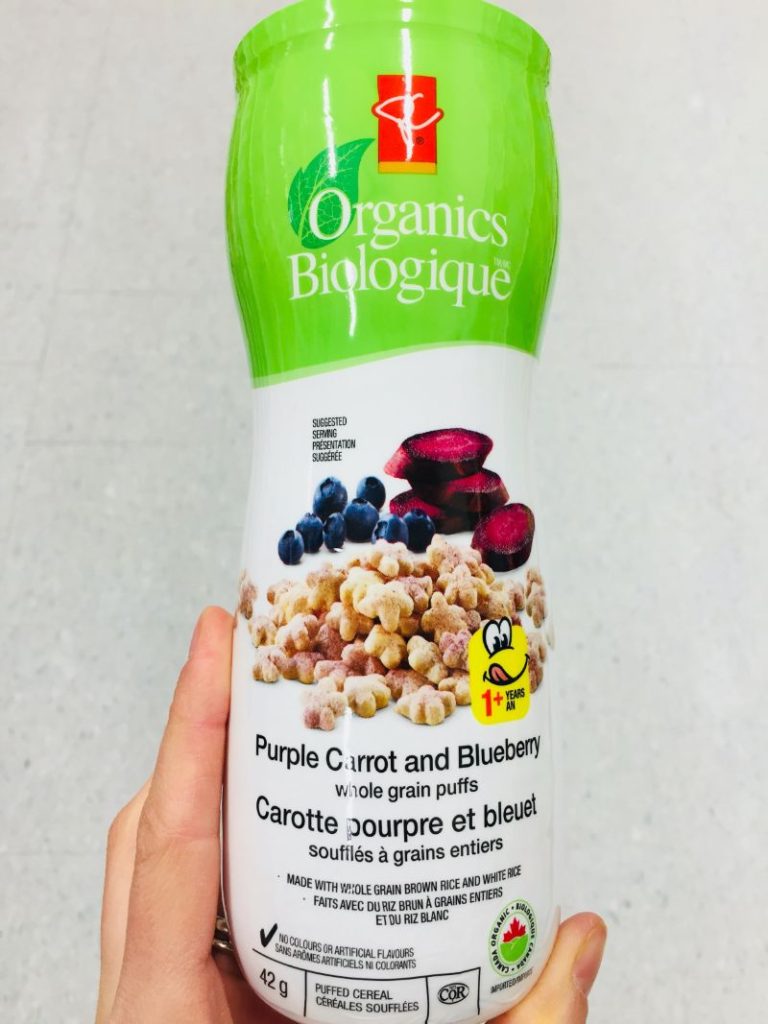
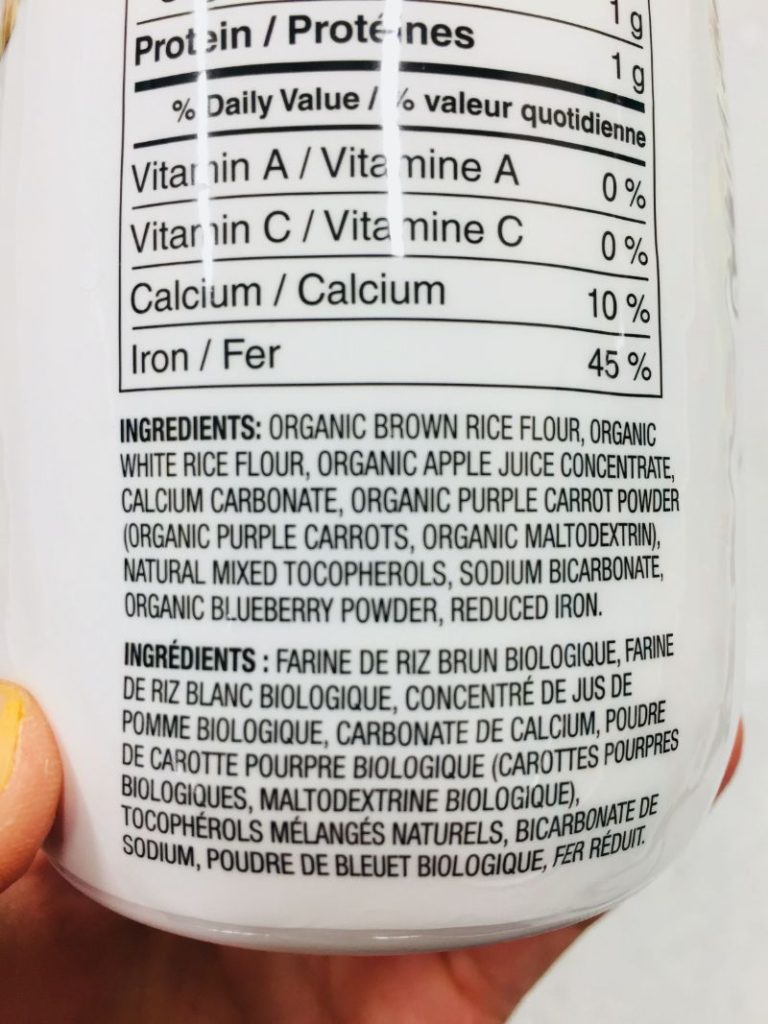
ORGANIC BROWN RICE FLOUR (whole grain flour), ORGANIC WHITE RICE FLOUR (white refined flour), ORGANIC APPLE JUICE CONCENTRATE (added sugar), CALCIUM CARBONATE (added calcium), ORGANIC PURPLE CARROT POWDER (ORGANIC PURPLE CARROTS (carrot powder), ORGANIC MALTODEXTRIN (added sugar)), NATURAL MIXED TOCOPHEROLS (vitamin E), SODIUM BICARBONATE (baking soda), ORGANIC BLUEBERRY POWDER, REDUCED IRON (added iron).
My take-home points from this episode of Inspector Gadget are:
- Although whole-grain flour (brown rice flour) is the first ingredient, white flour and added sugar are the second and third ingredients
- There are two added sugars present
- The healthy sounding purple carrots are present in powder form mixed with sugar and the amount of this carrot powder certainly cannot be considered as a replacer for eating real vegetables
I can hear you saying, “Alright Rosanne, do you have any better options for finger foods that are easy for babies to pick up and practice fine motor skills?” I am glad you asked. Why yes, I do. Here are a few to get you started:
- Smashed kidney or black beans with a drizzle of Extra Virgin Olive Oil (EVOO as I call it) – beans are the perfect bite-sized food that will boost your babe’s iron and protein intake. If you don’t have time to cook your own and are concerned about BPA in the lining of canned foods, you can find brands that don’t have BPA-lined cans (i.e. Eden organic)
- Small bite sized pieces of any soft fruit or soft cooked vegetable, as is or smashed like the beans.
- Little pieces of soft whole grain, whole wheat or sourdough bread dipped in some EVOO or with a thin spread of nut butter or avocado.
- Little cubes of soft tofu or scrambled eggs.
Age and ability will impact which of these finger foods you offer to your baby. The take home point here is that you don’t need to rely on puffs to develop self-feeding and fine motor skills.
#3 Baby Foods: Baby Cookies and Crackers
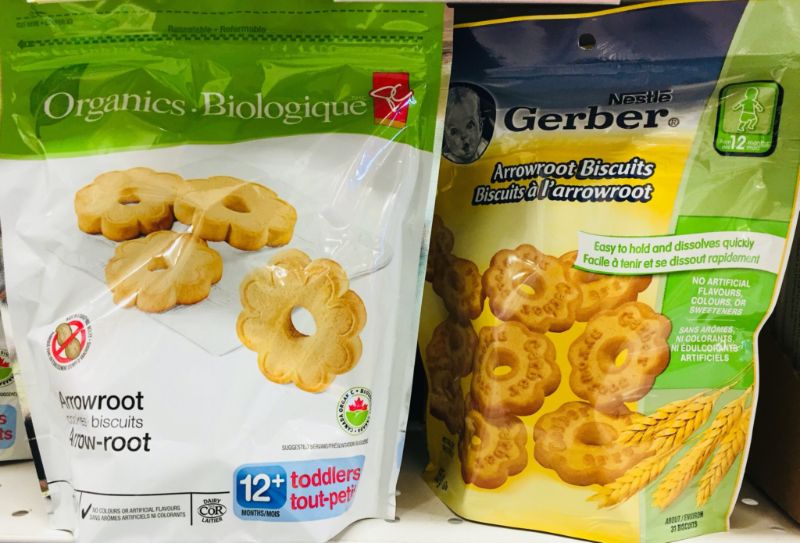
The mystery of how Mr. Christie Arrowroot cookies were endowed the title of “baby cookies” is mesmerising to me. These baby cookies that have “no artificial colours or flavours” are essentially composed of white flour, sugar and oil. Let me prove my point from the list of ingredients:
WHEAT FLOUR (white flour), SUGAR, SHORTENING …
There are other companies that produce arrowroot cookies, including PC Organic Arrowroot cookies, but their ingredient list mirrors the former:
ORGANIC ENRICHED WHEAT FLOUR (white flour), ORGANIC PALM OIL, ORGANIC CANE SUGAR
The organic label helps to elevate the statues of the latter cookie to the consumer, but as you can see, white flour, fat and sugar are the first three ingredients in both.
Toddler Mum-Mums brand are another popular cookie/cracker snack for babies. But, when we look at the first three ingredients in most varieties we see: organic rice flour (white flour), organic sugar, and sea salt.
Technically speaking, children under the age of two shouldn’t have ANY added sugar. Now, this is very difficult to achieve and in all honesty, I am actually a proponent of adding very small amounts of natural sugars and seasonings, in miniscule amounts to help take the bitter edge off some foods (i.e. some veggies). However, cookies composed predominantly of white flour, oil and sugar are better left on the shelf.
So what did we learn? All commercial baby foods are evil and you should NEVER give your child any? Not really what I was going for. What I hoped to have shared was that this food shouldn’t be the primary source of nutrition for your child (for various reasons). If these products are the foundation of your child’s diet, you might want to consider making some changes to whole foods from your kitchen table.
Feeding your baby food from your table is the easiest and best way to go from a nutritional standpoint and will likely motivate you and your family to eat healthier as well.
If you enjoyed this article, I recommend you check out this article; Nutritional Pet Peeves: Children’s Breakfast Cereal, before you leave. It might make all the difference to what you are struggling with or the information you are looking for.
Take it one bite at a time,
Rosanne
